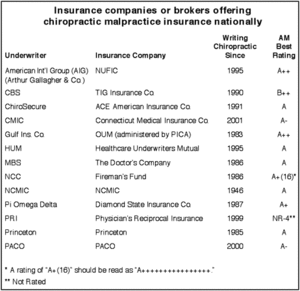A number of seemingly successful chiropractic malpractice insurance companies have gone out of business, leaving DCs scrambling to find another carrier. Reliance Insurance Company (a former CBS insurance company) was ordered into liquidation by the Pennsylvania Insurance Department on October 3, 2001, while PHICO, the state's second-largest carrier, according to AM Best State Product/Line reports for 2000, was liquidated on February 1, 2002.
Last year brought many changes to the chiropractic malpractice arena via mergers/acquisitions or clean breaks for some companies altogether:
- MLMIC (Medical Liability Mutual Insurance Company) announced that it has acquired two very large insurance companies in the Northeastern region: Princeton (principally operating in New Jersey), and Healthcare Underwriters Mutual (now known as the HUM division of MLMIC, principally operating in New York) and now surpassing St. Paul Property and Liability Insurance as the largest medical-malpractice insurer.
- St. Paul announced on December 14, 2001, that it would discontinue its medical malpractice program after experiencing adverse losses, leaving more than 42,000 medical physicians, hundreds of hospitals and hundreds of chiropractors scrambling to find coverage.
- OUM, which is underwritten by the Gulf Insurance Company, sold its chiropractic book of approximately 4,000 policyholders to the PICA Group; PICA now administers the OUM chiropractic program. PICA also acquired the PACO chiropractic program on Jan. 1, 1999. The PACO and PICA programs are entirely separate and have different policies, rates, rules and forms.
- Clarendon, the underwriter for Gulf Atlantic, announced it would dis-contine its chiropractic program, according to a letter sent to Gulf Atlantic policyholders during 2001 by Rogers, Atkins, Gunter and Associates. (Gulf Atlantic was endorsed by several state chiropractic associations.)
This leaves only 12 insurance companies or brokers offering chiropractic malpractice insurance nationally (see chart on page 61).
In today's market, the choice of a malpractice carrier should reside on more than just price. DCs should evaluate a variety of factors when choosing a malpractice carrier, as it is one of the most important practice decisions. Some of the questions that should be asked include:
- What is the financial stability of the carrier? (Information from your state insurance department and AM Best are good tools to use.)
- Is the carrier licensed in my state? (This is known as an "admitted carrier," and can have serious implications in the long run. You may not be protected by your state insurance guarantee fund if it is not an admitted carrier.)
- What is the carrier's longevity in the malpractice market?
- What is the carrier's policy coverage and exclusions?
- What is the carrier's price?
Most chiropractors have not seen a large impact on their malpractice premiums, but that could change. A number of companies that service the chiropractic profession are planning on raising their rates in the near future. TIG has already requested a 25 percent rate increase in at least 34 states for new and renewed chiropractic malpractice insurance policies purchased through Chiropractic Benefit Services (CBS).1
Because of the instability of the market today, it is more important than ever to be aware of the company that insures you, including the company's financial stability and whether it is an admitted carrier in the state in which you practice. If you choose insurance with a broker, look carefully at the insurance company they are insured with and confirm how they are rated. The insurance company is ultimately expected to protect you in the event of a claim. Some underwriters are more highly rated and therefore much more stable than others.
As an example, five carriers have underwritten Chiropractic Benefits Services' (CBS) coverage over the last 10 years. TransAmerica Insurance Company, Investor Insurance Company, Gulf Insurance Company and Reliance were each an insurance company for CBS policyholders from 1990 through 2000. In 2000, Reliance was in financial crisis, so CBS switched all of its clients' malpractice insurance coverage to TIG Insurance Company, which remains its current underwriter, though its rating was downgraded last November to B++, the lowest on the list.2
As stated in a previous article,3 the only way to protect insureds in the event their malpractice coverage is moved from a nonadmitted carrier (which Reliance was) to another carrier is to arrange a novation by the new insurance company. A novation is an agreement made with the new insurance company in which it agrees to retroactively cover all claims occurring during the old policy period, in addition to claims made under the new policies. This is extremely important. If an insurance company is not an admitted carrier and goes bankrupt, the insured has no protection through the state's insurance guarantee fund. This leaves the insured to pay out-of-pocket for any defense costs and settlements that arise.
In addition to having faith in the underwriting company, it is equally important you understand the terms of the policy you are purchasing. Many doctors have purchased a policy believing they have coverage for certain events, only to find out at the time of a claim that the particular coverage is excluded from their policy. Ask specific questions and read your policy thoroughly. Make certain that the coverage you thought you were buying is what you actually got. After a claim is filed, it is too late to discover that your coverage or your company is not what you thought it to be. Take time to read and review your policy carefully. It is without a doubt time well spent.
References
- CBS carrier files for 26% rate increase nationwide. Dynamic Chiropractic August 16, 2002. www.chiroweb.com/archives/20/17/04.html
- A.M. Best downgrades rating of TIG; affirms rating of Crum and Forster; affirms ratings of Fairfax and its subsidiaries. Press release 11/30/2001.
- Bankruptcy looms for Reliance/CBS: CBS malpractice insureds exposed. Dynamic Chiropractic November 30, 2000. www.chiroweb.com/archives/18/25/18.html
Dynamic Chiropractic editorial staff members research, investigate and write articles for the publication on an ongoing basis. To contact the Editorial Department or submit an article of your own for consideration, email
.





